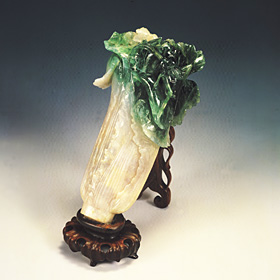I chose this photo of the jadeite cabbage from the Taiwanese National Palace Museum because it represents my heritage as well as my future. I feel a connection to this artifact because I was moved around from one country to another just like it was. This jadeite cabbage once belonged to the concubine of a Qing dynasty emperor. It was part of her dowry, and according to a documentary that I watched, the concubine would take it out often and gaze at it while she thought about her family. The jadeite cabbage also represents thoughts of my family and my homeland for me. After the Qing dynasty was overthrown, the Forbidden Palace was turned into a museum for historical artifacts and the cabbage was kept on display there. During the Chinese Civil War, the Nationalist army led by Chiang Kai Shek moved thousands of artifacts with them to Taiwan where they built a museum modeled after the Forbidden Palace. My grandfather on my mother’s side was a soldier in the Nationalist army and retreated to Taiwan where he established a new life. I really value this historical connection that my mother’s side of my family has to Mainland China, and that is what this jadeite cabbage represents.
Another key aspect of my life that the cabbage represents is my journey across the Pacific Ocean with my parents. My father decided that Vancouver is a much better city for me to grow up in, so we all immigrated here the year I turned eight. Growing up in Canada and learning to speak English while maintaining my Chinese language skills has been a long and arduous process. I can definitely relate to the students in my practicum who are just taking the class for easy credits. There were times when I hated learning Chinese because my mother made me copy Chinese literature and essays, and I argued so many times with her because I could not see the value in continuing to learn Chinese. In retrospect, I am thankful that my mother made me keep learning and that I obeyed. Being able to communicate with my family and people from my heritage culture is really important, and this is the message I want to convey to my future students. I hope that I can inspire them to see that taking my Mandarin class is more than just earning easy credits, and that they will walk away with a deeper connection to their Chinese heritage.
I wrote a poem to explain my artifact because poetry is a major part of my identity. I will always remember when I was in grade seven, my teacher selected me to read my Remembrance Day poem at the school assembly. In grade nine, my English teacher recognized my flair for poetry and encouraged me to enter my poems in poetry contests. My poem made it into a poetry anthology of student works. Poetry is one of my main methods of self-expression that I use to help me figure out what is going on in my life and in the world around me. Poetry will be a major part of who I am as a teacher because I want to instill the same love or at least appreciation for poetry in my students. Even if I teach one student each year to love reading and writing poetry, I will feel a sense of accomplishment.

